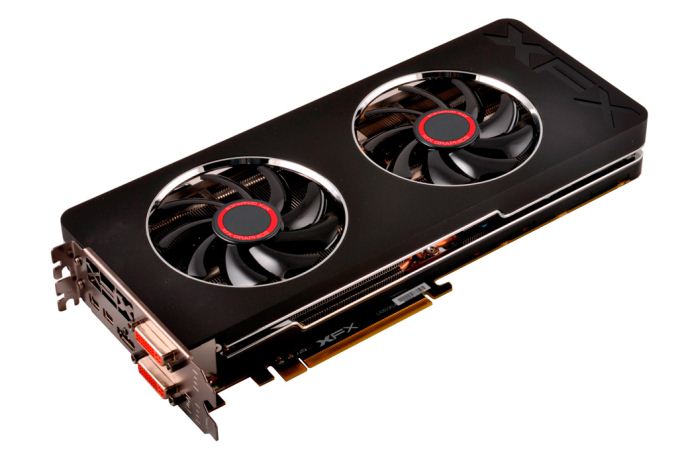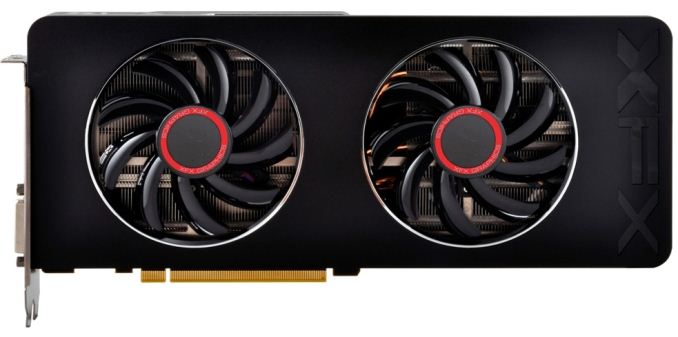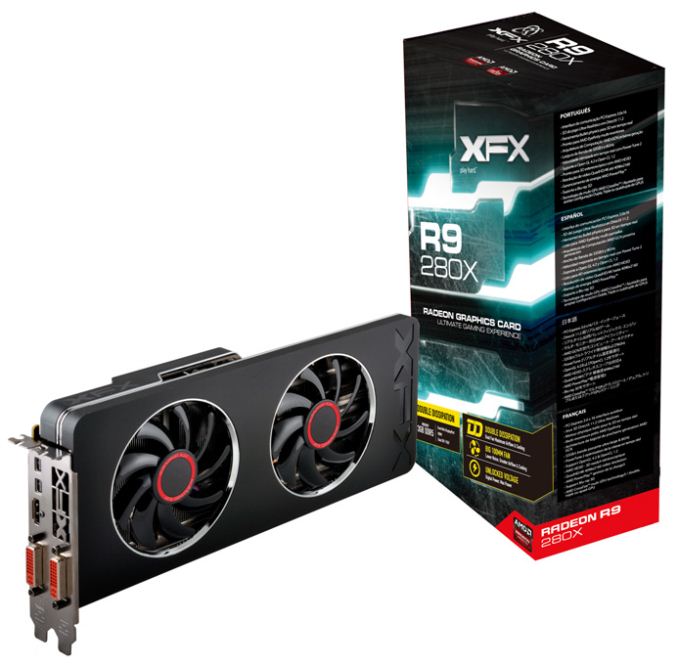The Radeon R9 280X Review: Feat. Asus & XFX - Meet The Radeon 200 Series
by Ryan Smith on October 8, 2013 12:01 AM ESTXFX Radeon R9 280X Double Dissipation
The first of our R9 280X cards is our reference-like sample, XFX’s Radeon R9 280X Double Dissipation. The R9 280X DD is XFX’s sole take on the 280X, utilizing a new and apparently significantly revised version of XFX’s Double Dissipation cooler, and paired with a 280X operating at the 280X’s reference clocks of 850MHz core, 1000MHz boost, and 6GHz RAM. Since there isn’t an overclock here, XFX will primarily be riding on their cooler, build quality, and other value add features.
Diving right into the design of the card, the R9 280X DD is a fairly traditional open air cooler design, as is common for cards in this power and price range. This basic design is very effective in moving large amounts of heat for relatively little noise, making the usual tradeoff of moving some of the cooling workload onto the system’s chassis (and its larger, slower fans) rather than doing the work entirely on its own.
In XFX’s case this is a new design, having forgone their older Double Dissipation design that we first saw on their 7970BEDD back in 2012. What’s changed? Without going into minute details, practically everything. At first glance you’re unlikely to even recognize this as an XFX card due to the fact that this is the first such product from XFX using this design, which aesthetically looks almost nothing like their old design.
First and foremost XFX has gone for the oversized cooler approach, something that’s become increasingly common as of late, equipping the card with one of the larger coolers we’ve ever seen. At 100mm in diameter the two fans on XFX’s design are among the biggest we’ve ever seen, pushing the card to just over 11.1 inches long while causing the heatsink and shroud to stand about 0.75” taller than the board itself.
Drilling down, XFX is using a two segment heatsink, the combined length of which runs the complete length of the card. Providing heat conduction between the GPU and the heatsink is a set of 6 copper heatpipes mounted into a copper base plate. 4 of these heatpipes run towords the rear of the card and the other 2 to the front, perpendicular to XFX’s vertical fin heatsink. Meanwhile cooling for the various discrete components on the board, including the memory, is provided by a separate cut-out baseplate that covers most of the card. There isn’t any kind of connection between the baseplate and the heatsink proper, so it’s the baseplate and any airflow over it that’s providing cooling for the MOSFETs it covers.
Moving on to XFX board, it looks like XFX isn’t doing anything particularly exotic here. XFX is using their standard Duratec high-end components, which includes using solid caps and chokes (typical for all cards in this power category) along with their IP-5X dust free fan. A quick component count has us counting 7 power phases, which would be the reference amount for a 280X, meaning we’re looking at 5 phases for the GPU, and another 2 phases for the memory and I/O.
Meanwhile for I/O XFX implements the common Radeon display I/O configuration of 2x DL-DVI, 1x HDMI, and 2x Mini DisplayPort 1.2. All the while external power delivery is provided by a set of 6pn + 8pin power connectors, as to be expected for a 250W card. With that in mind XFX’s design should have at least some overclocking headroom, but XFX doesn’t provide any overclocking software so you’ll need to stick with Catalyst Overdrive or 3rd party utilities such as MSI Afterburner.
Finally, as a Double Dissipation product the 280X DD is covered by XFX’s lifetime warranty policy, contingent on registering the card within 30 days of purchase. Interestingly XFX remains one of the few board partners that still offers any kind of lifetime warranty, making them fairly exceptional in that regard. As for pricing we’re listing the XFX card at $329 at the moment, though there is still some confusion over whether that’s the final price or not as our XFX rep seemed unsure of that. As is sometimes the case in this industry, we get the impression that they were waiting to see what other manufacturers were going to charge, in which case we suspect the actual launch price will be lower than that. We’ll update this article once we have final pricing information available.













151 Comments
View All Comments
maybeimwrong - Tuesday, October 8, 2013 - link
Perhaps I'm in the minority here, but I am concerned that I have to "Return to Anandtech" from a major new product review. This site is not AMDtech. If you want to have a special AMD section that aggregates relevant content, I'm fine with that. I am not fine with reviews being visible only in a place that presents no means of accessing general content on the site. Presenting review articles in this way is a terrible decision, and readers will stop trusting your content if you keep it up. I say this as a big fan of the site: please change the way "AMD" articles are handled immediately.SolMiester - Tuesday, October 8, 2013 - link
Hmmm, just noticed that....buy out complete?toyotabedzrock - Tuesday, October 8, 2013 - link
TrueAudio might die because they didn't add it to all their cards, very lazy and half baked.rtho782 - Tuesday, October 8, 2013 - link
Can you Crossfire an R280 with a 7970? Would make for a cheap upgrade path as they are basically the same card...hodakaracer96 - Tuesday, October 8, 2013 - link
I currently own a 2-way sli 770 setup so I may be biased. It seems NVIDIA can still charge a premuim (maybe $50) over the R9 280x due to much better SLI/crossfire capiblity (I know the newest AMD beta drivers fix latency issues, but the fact NVIDIA does frame pacing in hardware makes me feel better about it) and better performance/watt. My room gets pretty toasty and my 750 watt power supply is already on the edge. even an extra 50 watts from 2 - R9280x's would be unwanted.Frenetic Pony - Tuesday, October 8, 2013 - link
When it was AMD was firing key positions I knew it was bad, but now we know specifically HOW bad. Not a singe new GPU. I don't want Nvidia to have a monopoly damn it, maybe AMD should be looking at plans to sell to someone like Qualcomm if this holiday season doesn't hit it big for them.FuriousPop - Tuesday, October 8, 2013 - link
Aren't these the reference cards? So won't there be more tweaks, different coolers, OC's etc when the rest of them get a hold of it and start making their changes?If these truelly are reference cards, i thought these looked pretty good considering...
I understand an Asus one is tested - to be fair i have 2xasus 7970's tops, they tend to be slighty slower then the rest of the pack by little numbers however with better temps/noise lvls...
Bring on the 7970 bring bro aka. Titan Killer!
bwat47 - Monday, December 9, 2013 - link
Nvidia has done re-badges like this too, they both do it.b3nzint - Tuesday, October 8, 2013 - link
I see the cooler on r9-290x got 3 air tunnel at the back. Is ref. r9-280x will use the same cooler?Futureman666 - Tuesday, October 8, 2013 - link
now let's see NVidia lower the price of the GTX 770 4 GB so I can buy two of them and upgrade my rig . The price of those card are not right at the moment they should have been way lower . hope that AMD R9 will put enough pressure on NVidia . The only sour on this review seems once again AMD drivers (which seems to suck time and time again ) maybe Ryan did not have enough time to try 2 R9 280x card in crossfire .. I would have been impressed to see a comparison between the NVidia offerings 2 x gtx 760 and 2 x Gtx 770 in sli versus ... Maybe the damn drivers where not ready again to support these 2 cards in crossfire .. i'm eager to see the results